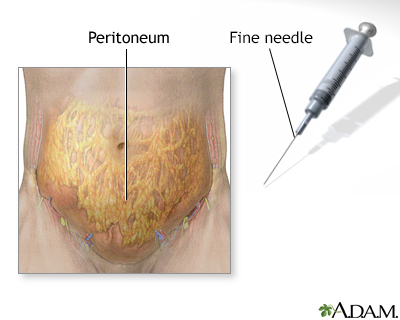Pregnancy SmartSiteTM
Secondary peritonitis DefinitionThe peritoneum is the thin tissue that lines the inner wall of the abdomen and covers most of the organs in the abdomen. Peritonitis is present when this tissue becomes inflamed or infected. Secondary peritonitis is when another condition is the cause. CausesSecondary peritonitis has several major causes.
An infection of the bloodstream (sepsis) may lead to an infection in the abdomen also. This is a severe illness. This tissue may become infected when there is no clear cause. Necrotizing enterocolitis occurs when the lining of the intestinal wall dies and can lead to peritonitis. This problem nearly always develops in an infant who is ill or born early. SymptomsSymptoms include:
Note: There may be signs of shock. Exams and TestsDuring a physical exam, the health care provider may notice abnormal vital signs with fever, rapid heart rate and breathing, low blood pressure, and a tender distended abdomen. Tests may include:
TreatmentOften, surgery is needed to remove or treat sources of infection. These may be an infected bowel, an inflamed appendix, or an abscess or perforated diverticulum, usually due to diverticulitis. General treatment includes:
Outlook (Prognosis)The outcome can range from complete recovery to overwhelming infection and death. Factors that determine the outcome include:
Possible ComplicationsComplications may include:
When to Contact a Medical ProfessionalContact your provider if you have symptoms of peritonitis. This is a serious condition. It needs emergency treatment in most cases. ReferencesMathews JB, Turaga K. Surgical peritonitis and other diseases of the peritoneum, mesentery, omentum, and diaphragm. In: Feldman M, Friedman LS, Brandt LJ, eds. Sleisenger and Fordtran's Gastrointestinal and Liver Disease. 11th ed. Philadelphia, PA: Elsevier; 2021:chap 39. Privratsky AM, Barreto JC, Turnage RH, Mizell J, Badgwell B. Abdominal wall, umbilicus, peritoneum, mesenteries, omentum, and retroperitoneum. In: Townsend CM Jr, Beauchamp RD, Evers BM, Mattox KL, eds. Sabiston Textbook of Surgery. 21st ed. St Louis, MO: Elsevier; 2022:chap 44. | |
| |
Review Date: 5/4/2022 Reviewed By: Michael M. Phillips, MD, Emeritus Professor of Medicine, The George Washington University School of Medicine, Washington, DC. Also reviewed by David C. Dugdale, MD, Medical Director, Brenda Conaway, Editorial Director, and the A.D.A.M. Editorial team. The information provided herein should not be used during any medical emergency or for the diagnosis or treatment of any medical condition. A licensed medical professional should be consulted for diagnosis and treatment of any and all medical conditions. Links to other sites are provided for information only -- they do not constitute endorsements of those other sites. No warranty of any kind, either expressed or implied, is made as to the accuracy, reliability, timeliness, or correctness of any translations made by a third-party service of the information provided herein into any other language. © 1997- A.D.A.M., a business unit of Ebix, Inc. Any duplication or distribution of the information contained herein is strictly prohibited. | |

 Peritoneal sample
Peritoneal sample
